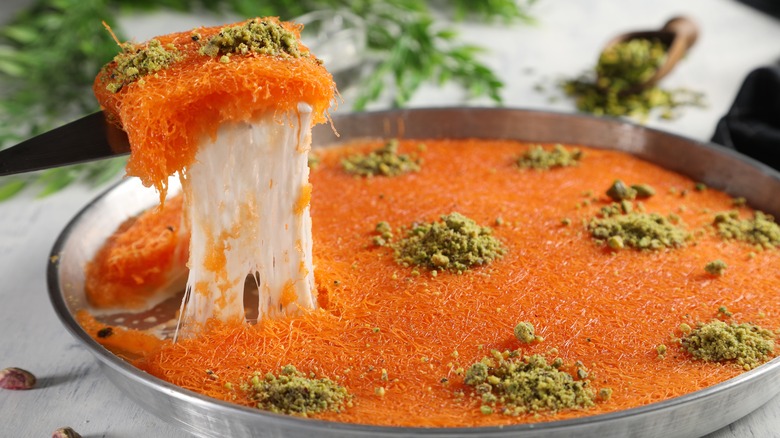Knafeh: The Middle Eastern Dessert With A Mysterious Origin Story
Middle Eastern cuisine boasts an impressive array of desserts. Whether it's the several dozen variations of baklava or the widespread simple honey cake, this part of the world makes sweet treats shine. Another iconic — and seriously delicious — sweet dish popular across the region is knafeh.
Called by alternate names like künefe in Turkey, kunafa in Egypt, and kanafa in Jordan, the dessert shares a common construction. It consists of thin strands of phyllo or semolina dough, fried to crispy perfection. In a small metal pan, the dough is layered with a soft melted cheese. This dairy filling alters per region, with selections that include mozzarella, ricotta, or a more localized style like unsalted Turkish Dil Peyniri. After baking, the dessert is covered in a fragrant syrup, and mixed with ingredients like citrus, rose water, or orange blossom extract. On top goes a sprinkling of chopped nuts, which are typically pistachios.
It's easy to understand the appeal of such a delightful contrast of crispy and gooey textures, underpinned with a balanced sweetness. However, who first came up with the dish — even down to a specific culture — is unknown. All that's clear is it emerged centuries ago and is now enjoyed by millions.
Knafeh is a Middle Eastern dessert with many regional variations
Despite its ubiquity across the Middle Eastern sphere, several locales have an especially strong connection to knafeh. The Palestinian city of Nablus is famous for its rendition featuring local cheese and set the world record for the largest knafeh ever recorded. Such strong ties have made some cite the city as the modern origin of the dish, although such claims are contentious.
Another famed regional rendition is Turkey's künefe, which hails from the country's Hatay province. Here, the dish is also made with a regional cheese that's especially stretchy and the dough is comprised of semolina rather than phyllo. The syrup contains lemon, spritzing up the dish with a tang. While varying renditions are found across Turkey, many have a special fondness for this region's version.
While two renowned varieties, these interpretations still don't evince where the dish emerged — historians don't even know the century. Some suggest it was created during the 10th century in what is today Damascus and enjoyed as a breakfast. Others accredit Egypt as the origin, with the first versions appearing around the 15th century. Regardless, the dish has attained enduring popularity. It's even reinterpreted into modern versions, too, with a Dubai chocolate marker crafting a viral knafeh bar.

